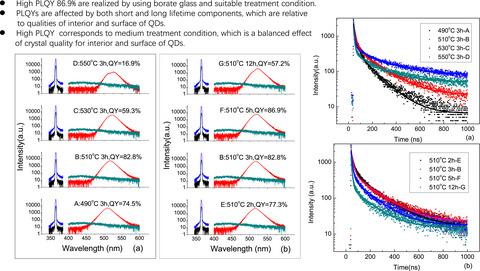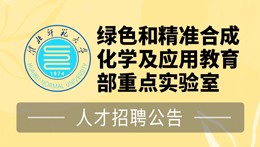当前位置:
X-MOL 学术
›
J. Am. Ceram. Soc.
›
论文详情
Our official English website, www.x-mol.net, welcomes your
feedback! (Note: you will need to create a separate account there.)
Improved photoluminescence quantum yield of CsPbBr3 quantum dots glass ceramics
Journal of the American Ceramic Society ( IF 3.5 ) Pub Date : 2020-05-22 , DOI: 10.1111/jace.17225
Xizhen Zhang 1 , Lizhu Guo 1 , Yuhang Zhang 1 , Chuanhui Cheng 2 , Yi Cheng 1 , Xiangping Li 1 , Jinsu Zhang 1 , Sai Xu 1 , Yongze Cao 1 , Jiashi Sun 1 , Lihong Cheng 1 , Baojiu Chen 1
Journal of the American Ceramic Society ( IF 3.5 ) Pub Date : 2020-05-22 , DOI: 10.1111/jace.17225
Xizhen Zhang 1 , Lizhu Guo 1 , Yuhang Zhang 1 , Chuanhui Cheng 2 , Yi Cheng 1 , Xiangping Li 1 , Jinsu Zhang 1 , Sai Xu 1 , Yongze Cao 1 , Jiashi Sun 1 , Lihong Cheng 1 , Baojiu Chen 1
Affiliation

|
We have fabricated CsPbBr3 perovskite quantum dots (QDs) in a multi‐component borate glass by melt‐quenching technique. Transmission electron microscopy (TEM) reveals a cubic phase CsPbBr3 crystal for QDs. As the treatment temperature or the treatment time duration increases, the photoluminescence (PL) peak shifts to long wavelength in the range of 510 to 525 nm, and the full width at half‐maximum varies in the range of 24 to 18 nm. The absorption edge shifts to low energy side in the range of 2.54 to 2.41 eV. The different photoluminescence excitation spectra (PLE) reflect the change of microstructure for different samples. The PL peak wavelength and line‐shape are independent of excitation wavelength. These results of spectra show typical exciton emission characteristics. As treatment conditions strengthens, photoluminescence quantum yield (PLQY) first increases and then decreases, having the best PLQY 86.9%. Bi‐exponential fitting curves show that short lifetime τ 1 continuously decreases. Long lifetime τ 2, weight for long lifetime component, and average lifetime τ avg first increase and then decrease. The PLQY values are affected by both τ 1 and τ 2, which are relative to the crystal quality in the interior and the surface of QDs, respectively. The high PLQY value corresponds to medium treatment condition, which is attributed to a balanced effect of crystal quality in interior and the surface of QDs.
中文翻译:

CsPbBr3量子点玻璃陶瓷的提高的光致发光量子产率
我们通过熔融淬火技术在多组分硼酸盐玻璃中制备了CsPbBr 3钙钛矿量子点(QD)。透射电子显微镜(TEM)显示立方相CsPbBr 3QD的晶体。随着治疗温度或治疗持续时间的增加,光致发光(PL)峰移至510至525 nm范围内的长波长,半峰全宽在24至18 nm范围内变化。吸收边移至2.54至2.41 eV范围内的低能侧。不同的光致发光激发光谱(PLE)反映了不同样品的微观结构的变化。PL的峰值波长和线形与激发波长无关。光谱的这些结果显示了典型的激子发射特性。随着处理条件的增强,光致发光量子产率(PLQY)首先增加然后降低,具有最佳PLQY 86.9%。双指数拟合曲线显示短寿命τ 1持续减少。长寿命τ 2,重量为长寿命成分,和平均寿命τ平均先增加后降低。的PLQY值由两个影响τ 1和τ 2,这是相对于分别在内部的晶体质量和量子点的表面上,。高PLQY值对应于中等处理条件,这归因于QD内部和表面的晶体质量平衡效果。
更新日期:2020-07-14
中文翻译:

CsPbBr3量子点玻璃陶瓷的提高的光致发光量子产率
我们通过熔融淬火技术在多组分硼酸盐玻璃中制备了CsPbBr 3钙钛矿量子点(QD)。透射电子显微镜(TEM)显示立方相CsPbBr 3QD的晶体。随着治疗温度或治疗持续时间的增加,光致发光(PL)峰移至510至525 nm范围内的长波长,半峰全宽在24至18 nm范围内变化。吸收边移至2.54至2.41 eV范围内的低能侧。不同的光致发光激发光谱(PLE)反映了不同样品的微观结构的变化。PL的峰值波长和线形与激发波长无关。光谱的这些结果显示了典型的激子发射特性。随着处理条件的增强,光致发光量子产率(PLQY)首先增加然后降低,具有最佳PLQY 86.9%。双指数拟合曲线显示短寿命τ 1持续减少。长寿命τ 2,重量为长寿命成分,和平均寿命τ平均先增加后降低。的PLQY值由两个影响τ 1和τ 2,这是相对于分别在内部的晶体质量和量子点的表面上,。高PLQY值对应于中等处理条件,这归因于QD内部和表面的晶体质量平衡效果。































 京公网安备 11010802027423号
京公网安备 11010802027423号